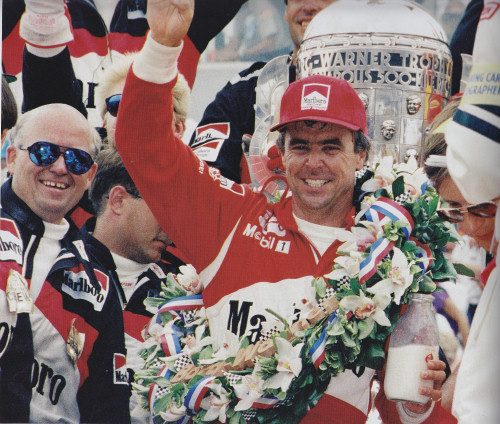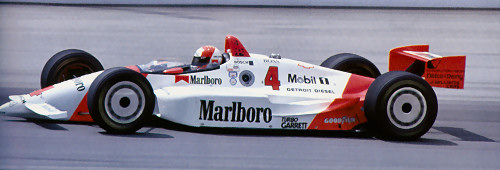The Way It Is/ Wise words from a racing geniusby Gordon Kirby |
 In recent years I've written many columns about downforce vs horsepower in Indy cars. I've discussed the matter in this space with the likes of Bobby, Al and Al Unser Jr., Mario Andretti, Parnelli Jones, Dan Gurney, John Barnard, Ben Bowlby, Nigel Bennett and others. I've enjoyed these conversations and hope you have too. Of course, the remarkable thing about these discussions is their consistency of thought and agreement in redefining the concept of today's Indy car such that downforce is reduced and horsepower increased.
In recent years I've written many columns about downforce vs horsepower in Indy cars. I've discussed the matter in this space with the likes of Bobby, Al and Al Unser Jr., Mario Andretti, Parnelli Jones, Dan Gurney, John Barnard, Ben Bowlby, Nigel Bennett and others. I've enjoyed these conversations and hope you have too. Of course, the remarkable thing about these discussions is their consistency of thought and agreement in redefining the concept of today's Indy car such that downforce is reduced and horsepower increased.
Renowned Indy car designer Bennett took the time to think through and present a detailed formula for reducing downforce and tire grip while improving the aesthetic appeal of modern open-wheel cars. Many people in the sport agree with Bennett's prescription and his proposed solutions but nobody in the halls of power of the either the FIA in Paris or IndyCar in Indianapolis have stepped forward to engage Bennett in conversation or explore his ideas. This is disappointing but unsurprising. In the recent weeks I've explored IndyCar's aero kit program with the major players at IndyCar, Honda and Chevrolet. Clearly, everyone is working hard to make both their own and the overall aero kit program a success. I share these hopes but like many people I continue to be skeptical about increasing rather than decreasing downforce. I'm among those--including IndyCar champion Will Power--who believe the sanctioning body will have to tackle solving the sport's essential modern equation. "I'm pushing for it all the time man!" Will declares. "More power. Cut the downforce. That's what I want. It's what we all want."  © Indianapolis Moter Speedway "One of the things I always say is downforce to a driver is like money," Mears observes. "If you made $50,000 one year and then $100,000 the next year and you told me you were going to cut me back to $50,000 you would say that's impossible. I can't live on that little money. But if you have to, you discover that, you know what? It can be done. "I remember a few times in the CART days we would try running less downforce and the first few laps I didn't like it, but after I had run thirty or forty laps I liked it. I felt like I was driving the car again, like I had more input. "Then they would try it with some other drivers and right away some of them would say, 'You're trying to kill me!' So there were always arguments about taking off downforce and there always will be. "But eventually, it has to happen. I've said it for five or six years and I know others have said the same thing, and maybe one day some other people will wake up and say, 'You know what? Aerodynamics is the worst thing that ever happened to motor sports.' "Today, aerodynamics controls the sport. It dictates everything about the car. They've been going down a path with more and more downforce and they're just boxing themselves into a corner. It's like anything. At one point something is good but then it reaches a level that it's bad for business. The drivers don't want pack racing but they can't seem to get away from a formula that doesn't create pack racing.  © Steve Swope "We've made the cars stronger and safer, we've built safer walls and better catch fences. The sport has done a tremendous job but you can't keep going down this path. If you reduce the downforce and reduce the lateral load on the cars you make all these things better. In effect, you make everything--the cars, the walls, the catchfences--safer than they are now. "To me, I want to drive the car. That's what I love doing and that's what I get paid for. There's driving and there's guiding, and they're two different things. I like to drive it, not guide it. The more driver aids we have, the less input. "To me, the fun part was: give me more power than I can use and let me figure out how to use it better than the next guy." For anyone who doesn't fully appreciate it, allow me to emphasize that these are the words of one of motor racing's rare geniuses who was a sublimely smooth driver. To ignore Rick's observations is to the sport's peril. Heeding and understanding them is essential to the future of the Indy 500 and Indy car racing. *Penske Racing veteran Earl MacMullen has passed away. MacMullen died last Friday at a hospital near his home in Reading, PA following a long illness. Earl joined Penske Racing in 1969, originally working on the Trans-Am team. He went on to become the team's transmission expert building gearboxes for the team's Can-Am and Indy cars. MacMullen retired in 1998 after thirty years with Penske. He was married to Jean McMullen who was Penske Racing's secretary from 1980-2000. Jean was at Earl's bedside when he passed away last week. |
|
Auto Racing ~ Gordon Kirby
Copyright ~ All Rights Reserved |
